Australian housing is overvalued. Nobody denies it. Debate remains, however, about how overvalued. Surveys by The Economist and Demographia claim Australian housing is the most expensive in the world. On the other hand, the Reserve Bank of Australia and local data providers like Rismark acknowledge the overvaluation but see it as less extreme and sustainable.
The MacroBusiness Housing Valuation and Investment Report is here to settle the debate. For the report, we have used the best available data from both public and private sources.
International valuation measures
To correctly understand the valuation of Australian housing, we must first place it in its international context. Australian housing’s performance relative to other English speaking nations is shown in the below charts. First, nominal house prices:
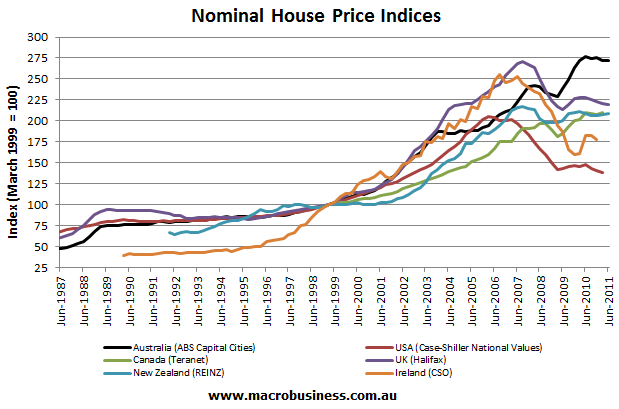
Although in the lead up to the global financial crisis (GFC) Australia’s housing market did not rise as quickly as some other countries – most notably the United Kingdom and Ireland – values have so far remained steadfast, avoiding the large falls experienced in those markets following the onset of the GFC. This has left Australian housing as the star performer based on headline price growth.
The results are similar when home prices are adjusted for inflation; although Australia’s house price performance is less spectacular owing to its steadier appreciation over a longer time frame:
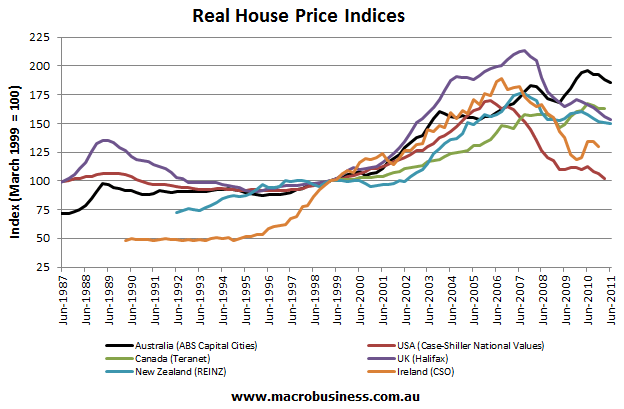
However, conducting cross-country valuations of housing markets is inherently difficult, since data is often either not readily available or there are inconsistencies in the way that data is compiled. As such, it is difficult to directly test The Economist’s and Demographia’s claims that Australian homes are expensive by international standards.
Thankfully, all of the English speaking nations in the Demographia Survey, except Ireland, maintain statistical databases of gross domestic product (GDP) and the total value of the residential housing stock.
The ratio of total residential housing assets to GDP for each of these nations (except Ireland) is shown below, based on the latest available data:
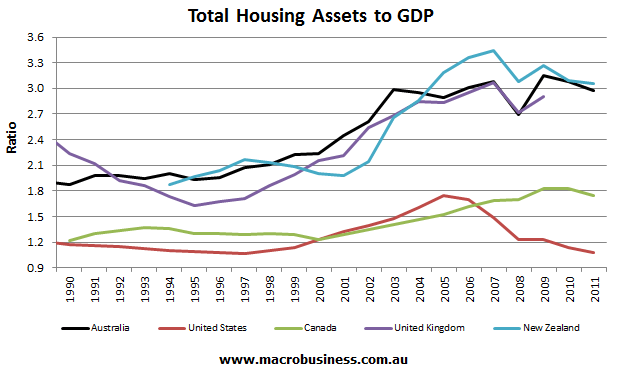
As you can see, Australia’s ratio is around 3.0 times currently, which is just below New Zealand but higher than the United Kingdom and considerably more so than the United States and Canada.
Australia’s ratio has also risen by around 50% since the late-1990s on the back of strong house price appreciation that far exceeded growth in the broader economy.
The ratio of housing assets to GDP confirms the view that Australian housing is relatively expensive by international standards; although it does not confirm that Australian housing is the most expensive amongst the English speaking nations as claimed by Demographia and The Economist.
Domestic valuation measures
Having confirmed that Australian housing is expensive by international standards, let’s now turn to some domestic valuation techniques.
The first valuation method is the calculation of Median Multiples – defined as the median dwelling, house or unit price divided by the median household disposable income – for Australia’s major housing markets. The data inputs for this calculation have been obtained from the following sources:
- Median dwelling, house and unit values have been obtained from the July RPData-Rismark Hedonic Home Value Index report.
- Median household disposable incomes have been calculated from the Australian Bureau of Statistics (ABS) 2009-10 Household Income and Income Distribution Survey and adjusted for wages growth since December 2009 using ABS data as well as taxes.
The first chart summarises Australia’s Median Multiples for dwellings (both houses and units):
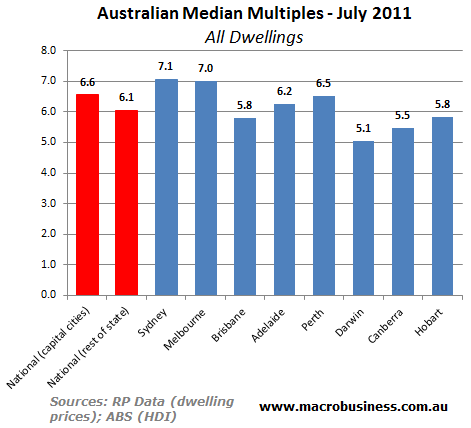
As you can see, Australia’s national Median Multiples at the capital city and rest-of-state levels are 6.6 and 6.1 respectively. Sydney (7.1) and Melbourne (7.0) are the most expensive capital cities, whereas Darwin (5.1) and Canberra (5.5) are the least expensive.
No major Australian housing market could be considered affordable under this measure. Each market’s Median Multiple is well in excess of 3.0 times, which is commonly considered the benchmark for an affordable housing market and represents the level of house prices relative to incomes that was commonplace in Australia in previous generations.
As expected, the Median Multiples pertaining to Australian houses are higher:
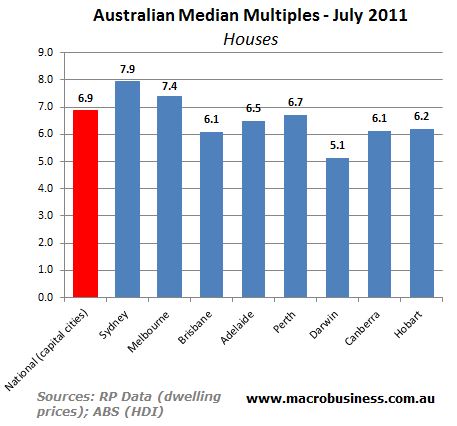
Whereas, the Median Multiple pertaining to units are lower:
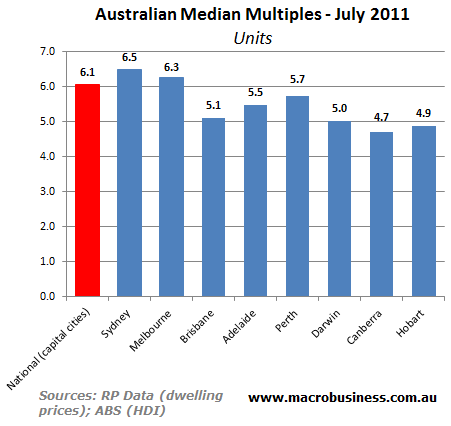
An analysis of Australian housing valuations would be incomplete without an examination of the rental returns from housing relative to the cost of finance as well as the returns available from other forms of investment.
First, consider the growth of Australian house prices, as measured by the ABS, against the ABS measure of rental inflation (used in calculating the Consumer Price Index):
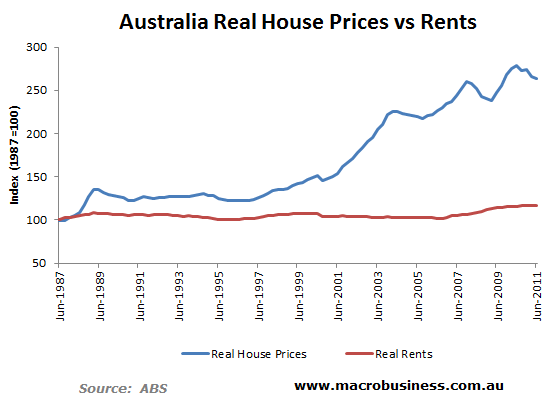
At the national level, the growth of Australian house prices has far exceeded the growth of rents, suggesting that the housing market is significantly overvalued.
However, one potential limitation of comparing the ABS measures of house prices against rental inflation is that the ABS adjusts rental costs for changes in quality via hedonic regression, whereas their house price index is not. As such, rental growth might be understated relative to house price growth, potentially overstating the level of overvaluation.
As an alternative method of valuation, I have calculated the gross national capital city rental yield from Australian Property Monitors (APM) rental data and compared these results against: (1) the discount variable mortgage rate; and (2) the average yield available on a one-year bank term deposit.
First, consider median gross rental yields for both houses and units against the average discount variable mortgage rate. For houses:
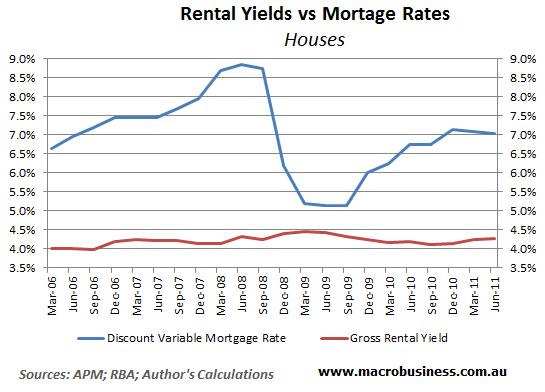
And units:
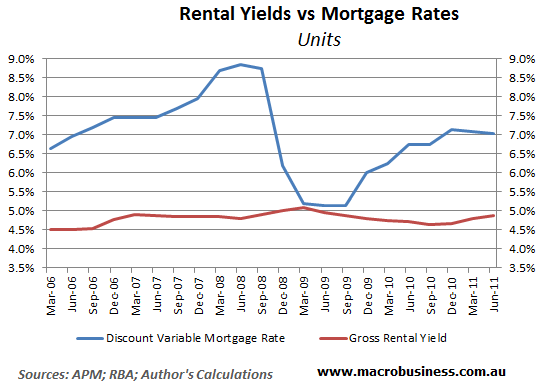
Since 2006, median gross rental yields have typically been well below the discount variable mortgage rate. Therefore, the average dwelling purchased over this period by an investor using finance (rather than savings) has been negatively geared, meaning that the investor has essentially been paying their dwelling a dividend in the hope that the dwelling repays them with some capital growth.
Even for the housing investor that has purchased their dwelling outright using savings (i.e. ungeared), the median rental return has been relatively poor. To illustrate this point, the below charts compare the median gross capital city rental yield against the average one-year term deposit rate. For houses:
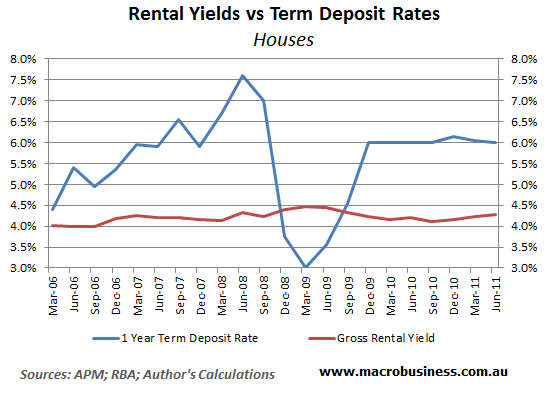
And units:
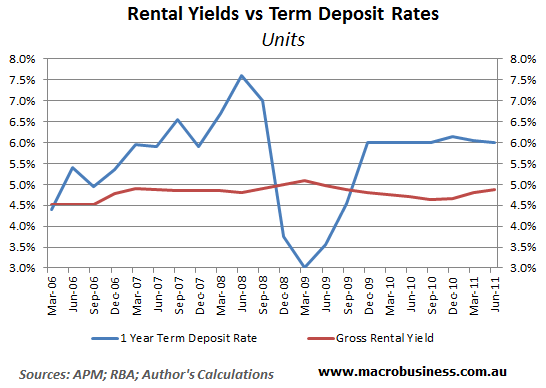
Except for the period between September 2008 and September 2009, gross rental yields have typically been below the yields available on a one-year term deposit. Given Australian housing’s higher risk profile, this result suggests that residential property investors have been banking on making solid capital returns in order to compensate for the poor rental returns on offer.
Of course, the above comparisons of rental returns relative to mortgage and term deposit rates do not take into consideration the tax preferred nature of Australian housing – in particular the ability to write-off income losses against other forms of income (negative gearing). At the same time, the rental returns shown above are provided on a gross basis – that is, before expenses such as maintenance costs, agents fees, rates, body corporate fees, and land taxes. They also do not take into account purchasing costs, including stamp duties.
What should be apparent from the above analysis is that Australian housing is relatively expensive. And without continued solid capital growth – an unlikely prospect given the already high levels of household debt and the deteriorating global economic environment – the investment fundamentals currently do not stack-up for Australian housing.
In future Special Reports, I will focus on housing at the capital city level.

